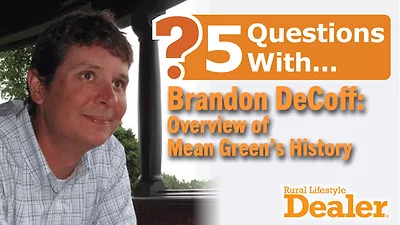Jim Paugh, the newly elected president of the Outdoor Power Equipment Aftermarket Assn. (OPEAA), says his number 1 goal is to improve communication with members.
“It’s not just about what we’re doing as an organization, but to be a voice. We want to improve our message and get the information out to our members and then filter that information down to our dealer base,” Paugh says. He is the power equipment accounts manager, aftermarket division, for NGK Spark Plugs.
He says that message is about helping his industry cope with such issues as dealer consolidation, government regulations and new technologies. Those messages and strategies will be based on the group’s mission to promote the quality of replacement parts as an equivalent and economical means for the maintenance and repair of power equipment.
Supporting Declining Dealer Base
Paugh says the association is watching dealer consolidations and the challenges and opportunities it bring to the aftermarket industry.
“Thirty years ago, there used to be more than 30,000 independent OPE (outdoor power equipment) dealers nationally. Today, that number is estimated to be between 5,000 and 15,000. My guess is that it’s about 10,000 nationally. Big dealers are getting bigger and bigger. The mid-sized dealership is struggling to grow. It’s difficult for them to make the jump to the next level because of the investment required. Then, we have the ‘backyarders,’ the dealers strictly doing service work, which I don’t see going away,” Paugh says. “How can we better service all these dealers? We need to make sure our products are equal in quality to the OEMs.”
He says the declining dealer base will drive quality for both the OEMs and the aftermarket industry.
 Jim Paugh is President of the Outdoor Power Equipment Aftermarket Association. |
“It’s an opportunity to become better at what we do. When the competition gets tough, that’s when products and services get better. That benefits independent dealers,” Paugh says.
He says the industry can also help independent dealers with better inventory management. For instance, manufacturers may need to rethink inventory incentive programs.
“There are programs for dealers to stock up on eight or nine months of inventory. That’s nice to get the product in the door, but if we have a dry year like last year, then dealers are sitting on inventory and that costs them money,” he says. “For manufacturers to load up distributors with product and for distributors to load up dealers, that can’t be done anymore.”
A better approach is to offer programs that allow for weekly orders or even multiple orders in a week. “This allows dealers to both stock fast-moving parts and order slower moving parts for the current jobs on the bench. The last thing you want to do is run out of air filters on a Saturday.”
Coping with New Regulations
Government regulations also mean challenges and opportunities for the aftermarket industry. For instance, Paugh says the EPA will continue to force engine manufacturers to find ways to reduce exhaustive and evaporative emissions and improve fuel economy. OPE manufacturers are taking advantage of electronic fuel injection as a way to meet regulations. Aftermarket manufacturers need to make new investments to match this technology and maintain quality.
“The increased technology will make it difficult for consumers to choose anything other than a high quality brand. This is an opportunity for the aftermarket industry to increase profitability. The world of the $1 spark plug is quickly disappearing,” Paugh says.
Partner to Grow
OPEAA has identified market data collection as a key initiative for 2013 and will expand on the parts surveys it already conducts with members. The group will soon gather data about specific products — string trimmers, blades and spark plugs for example.
“It’s about asking, ‘In my piece of the world, am I getting all the business I can? What is the potential for me?’” Paugh says.
Distributors can be the pipeline to help that data reach dealers and help educate them on issues, such as the effect on small engines when gasoline with 15% ethanol is used. The distributor/dealer relationship has evolved beyond the days of the “bread route,” where a representative visited the same dealers on the same days.
“Dealers don’t want that anymore. I believe the dealer still wants to see a rep, but wants that rep to bring him information and help them stay on top of things they might not have time for … to be a partner,” he says.
The partnership philosophy is important for the industry in other ways. For example, OPEAA has started to develop a relationship with groups like the National Hispanic Landscape Alliance to see how the aftermarket industry can meet its members’ needs.
Paugh says the industry and dealers also have to look at partnerships with those who might be considered competitors. For dealers, this might be major retailers.
“Dealers have the opportunity to service equipment sold through big box stores. However, sometimes the cost of the repair is not worth it. This issue is an ongoing challenge for our industry,” he says. “The upside with accepting equipment for service is the opportunity to sell new equipment. Some brands are also sold both in independent and big box stores. The challenge is having the consumer understand that just because it’s sold in the big box stores doesn’t mean it’s cheaper.”
Competing with OEMs
Paugh says he knows OEMs push dealers to carry original parts, and rightfully so, to promote their brands. However, the separation between original equipment and aftermarket is not as clear-cut as it used to be.
“There’s a blurring of the lines. Certain distributors used to sell only to OEMs and now they sell to both. There’s still competition between us, but there’s also an understanding that we’re all players in a very small industry. We’re competing, but also joining forces,” Paugh says.


.webp?height=254&t=1755550502&width=198)



